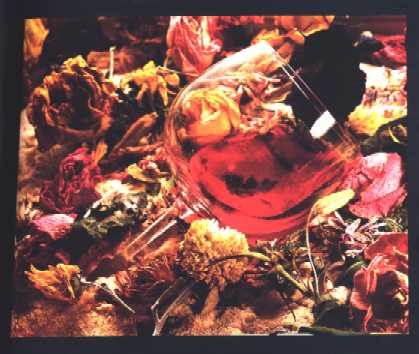

Tasting and drinking - what is the difference? It can be compared to test-driving a car you are about to buy and the relaxed enjoyment of driving it afterwards. For one, you concentrate on what is happening and attempt to zero-in on any faults, for the other the senses are relaxed and you simply enjoy the experience. Tasting is a matter of concentration, and the technique involved is something to anyone can acquire.

How to taste
When tasting a wine it is important to eliminate all distractions especially comments made by others; it is all too easy to be swayed. The wine should be tasted and an opinion registered before any ensuing discussions. Even at professionally led tasting, the expert's job is not to dictate but to educate, to lead from behind, putting into perspective other people's natural responses to smells or tastes through clear and concise explanation.
The three "basics" of wines are sight, smell, and taste known as "eye", "noise", and "palate".
The sight or "eye" of wine
The first step in evaluating the appearance of a wine is to assess its limpidity, as all wines should be perfectly clear. Many wines throw a deposit, but this is harmless if it settles to yield a bright and clear wine. A wine that is poured and allowed to settle, but remains cloudy or hazy, should be discarded. Tiny bubbles that appear on the bowl or cling persistently to the edge of the glass are perfectly acceptable in a few types of wines, such as Muscadet sur lie and Vinho Verde, but probably indicate a flaw in most other still wines.
The next step is to swirl the wine gently round the glass. So-called "legs" or "tears", thin sinewy threads that run down the side of the glass, may appear. Contrary to popular belief, they are not indicative of high glycerol content, but are simply the effect of alcohol on wine's viscosity, or the way the wine flows. The greater the alcohol content the less free-flowing, or more vicious, the wine actually becomes.
The colours of wine
Natural light is best for observing a wine's colour, the first clues to identity once its condition has been assessed on first sight. Look at the wine against a white background, holding the glass at the bottom of the stem and tilting it away from you slightly. Red wines vary in colour from clairet, which is almost rose, to tones so dark and opaque they seem black. White wines range from a colourless, water-white to deep gold, although the majority are a light straw-yellow colour. For some reason there are very few rose wines that are truly pink in colour, the tonal range extending from blue-pink, through purple-pink to orange-pink. Disregard any impression about a wine's colour under artificial lighting because it will never be true- fluorescent light, for example, makes a red wine appear brown.
The smell or "nose" of a wine
Whenever an experienced taster claims to be able to recognize in excess of 1,000 different smells, many wine-livers give up all hope of acquiring the most basic tasting skills. Yet they should not. An experienced taster can detect and distinguish over 1,000 different smells, but so can everybody; the majority of these smells` are ordinary everyday odours. Ask anyone to write down all the smells they can recognize and most will be able to list several hundred without really trying. Yet a far greater number of smells are locked away in our brains waiting to be triggered off by a similar odour. No smells are specific to wine as they can all be compared to something familiar.
The wine-smelling procedure is quite simple; give the glass a good swirl, put your nose into the glass and take a deep sniff. While it is essential to take a substantial sniff, it is not practicable to sniff the same wine again for at least two minutes. This is because each wine activates a unique pattern of nerve ends in the olfactory bulb, which is situated a the top of the nose; these nerve ends are like small candles that are snuffed out when activated and take a little time to reactivate. As a result, subsequent sniffs of the same smell can reveal less and less, yet it is perfectly feasible to smell different smells, therefore different wines, one after another.
The taste or "palate" of a wine
As soon as one sniffs a wine, a natural reaction is to taste it, but do this only after all questions concerning the nose have been addressed. The procedure is simple, although it may look and sound rather strange to the uninitiated. Take a good mouthful and draw air into the mouth through the wine. This makes a gurgling sound, but it is essential to do it in order to magnify the wine's volatile characteristics in the back of the throat.
The tongue itself reveals very little; sweetness is detected on its tip, sourness or acidity on the sides, bitterness at the back and top, and saltiness on the front and sides. Apart from these four basic taste perceptions, we smell tastes rather than taste tastes. Any food or drink emits odourous vapours in the mouth that are automatically conveyed to the roof of the nasal passages. Here, the olfactory bulb examines, discerns, and catalogues them - as they originate from the palate the natural inclination is to perceive them as tastes. For many of us it is difficult to believe that we taste with an organ located behind the eyes at the top of the nose, but when we eat ice-cream too quickly, we painfully experienced precisely here the olfactory bulb is.
-source: Sotheby's World Wine Encyclopedia by
Tom Stevenson
![]()